NASA’s Dawn mission cancelled
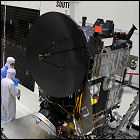 Having been “on hold” since October 2005 pending an audit of technical and managerial issues related to the mission, NASA formally cancels the Dawn unmanned mission to the asteroid belt. The spacecraft had been intended to lift off in 2006, using an ion propulsion system to visit, orbit, and map not one, but two, of the largest bodies in the asteroid belt between Mars and Jupiter, in the following decade. The mission is cancelled when NASA auditors find unresolved technical issues and project a budget overrun of 20%. Planners and managers for the Dawn mission plan to appeal NASA’s decision.
Having been “on hold” since October 2005 pending an audit of technical and managerial issues related to the mission, NASA formally cancels the Dawn unmanned mission to the asteroid belt. The spacecraft had been intended to lift off in 2006, using an ion propulsion system to visit, orbit, and map not one, but two, of the largest bodies in the asteroid belt between Mars and Jupiter, in the following decade. The mission is cancelled when NASA auditors find unresolved technical issues and project a budget overrun of 20%. Planners and managers for the Dawn mission plan to appeal NASA’s decision.

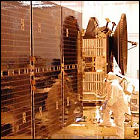 NASA reverses a decision made earlier in the month to cancel the asteroid-hopping Dawn mission, following appeals and assurances from the mission managers. Intended to use ion propulsion to visit to of the asteroid belt’s largest bodies, Dawn’s cancellation does have the effect of sliding the mission from a 2006 launch to a 2007 launch. The budget for the mission is expanded from $373,000,000 to $446,000,000, and arrival at its first target, the large asteroid Vesta, is still scheduled for 2011.
NASA reverses a decision made earlier in the month to cancel the asteroid-hopping Dawn mission, following appeals and assurances from the mission managers. Intended to use ion propulsion to visit to of the asteroid belt’s largest bodies, Dawn’s cancellation does have the effect of sliding the mission from a 2006 launch to a 2007 launch. The budget for the mission is expanded from $373,000,000 to $446,000,000, and arrival at its first target, the large asteroid Vesta, is still scheduled for 2011.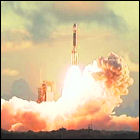 NASA launches the unmanned Dawn spacecraft, a vehicle designed to explore the two largest bodies in the asteroid belt between Mars and Jupiter. Dawn will also test a new charged ion propulsion system designed to improve on the performance of traditional chemical propellants (though its fine-tuning reaction control system will still use small engines powered by “rocket fuel”). Dawn is intended to visit and orbit the asteroid Vesta in 2011, which it will then depart after mapping to explore Ceres in 2015.
NASA launches the unmanned Dawn spacecraft, a vehicle designed to explore the two largest bodies in the asteroid belt between Mars and Jupiter. Dawn will also test a new charged ion propulsion system designed to improve on the performance of traditional chemical propellants (though its fine-tuning reaction control system will still use small engines powered by “rocket fuel”). Dawn is intended to visit and orbit the asteroid Vesta in 2011, which it will then depart after mapping to explore Ceres in 2015.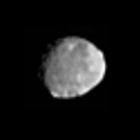 From a distance of 117,000 miles, NASA’s Dawn unmanned space probe captures the best picture yet of the asteroid Vesta, one of the two largest bodies in the solar system’s main asteroid belt between Mars and Jupiter. Launched in 2007, Dawn is scheduled to orbit and map Vesta before moving on to the asteroid belt’s largest resident, Ceres, in 2015. Mission scientists hope that the two asteroids – remnants of what may be an unformed or destroyed rocky planet beyond Mars’ orbit – will yield clues about the formation of the solar system.
From a distance of 117,000 miles, NASA’s Dawn unmanned space probe captures the best picture yet of the asteroid Vesta, one of the two largest bodies in the solar system’s main asteroid belt between Mars and Jupiter. Launched in 2007, Dawn is scheduled to orbit and map Vesta before moving on to the asteroid belt’s largest resident, Ceres, in 2015. Mission scientists hope that the two asteroids – remnants of what may be an unformed or destroyed rocky planet beyond Mars’ orbit – will yield clues about the formation of the solar system.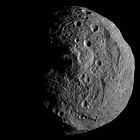 Launched in 2007, NASA’s unmanned space probe Dawn enters orbit of Vesta, one of the largest bodies in the main asteroid belt between Mars and Jupiter. Over time, the mission plan calls for Dawn to spiral down to lower orbits to explore and map Vesta from orbit, trying to determine what secrets the large asteroid has about the earliest days of the solar system. If all goes well, Dawn will remain at Vesta until 2012, and will depart to explore another asteroid, Ceres, arriving there in 2015.
Launched in 2007, NASA’s unmanned space probe Dawn enters orbit of Vesta, one of the largest bodies in the main asteroid belt between Mars and Jupiter. Over time, the mission plan calls for Dawn to spiral down to lower orbits to explore and map Vesta from orbit, trying to determine what secrets the large asteroid has about the earliest days of the solar system. If all goes well, Dawn will remain at Vesta until 2012, and will depart to explore another asteroid, Ceres, arriving there in 2015.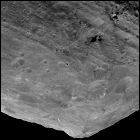 NASA’s unmanned Dawn spacecraft, having completed its high-altitude mapping of the asteroid Vesta, drops to a lower altitude for more detailed mapping of Vesta’s surface. On average, its new orbit will allow Dawn to circle Vesta at an altitude of 130 miles, down from its previous 430-mile-high altitude. Dawn is imaging Vesta stereographically, allowing for precise measurements of surface features and the asteroid’s overall shape. In 2012, Dawn is scheduled to fire its ion thruster again, breaking orbit and leaving Vesta for a three-year cruise to the largest body in the asteroid belt, Ceres, arriving in 2015.
NASA’s unmanned Dawn spacecraft, having completed its high-altitude mapping of the asteroid Vesta, drops to a lower altitude for more detailed mapping of Vesta’s surface. On average, its new orbit will allow Dawn to circle Vesta at an altitude of 130 miles, down from its previous 430-mile-high altitude. Dawn is imaging Vesta stereographically, allowing for precise measurements of surface features and the asteroid’s overall shape. In 2012, Dawn is scheduled to fire its ion thruster again, breaking orbit and leaving Vesta for a three-year cruise to the largest body in the asteroid belt, Ceres, arriving in 2015.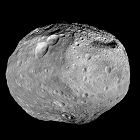 NASA’s Dawn unmanned space probe fires up its ion propulsion system, breaking its orbit around the large asteroid Vesta. Having orbited and mapped Vesta since 2011, Dawn must now survive a nearly-three-year trip through the main asteroid belt to reach the largest body in that region, Ceres. Successful arrival at Ceres, planned for 2015, would make Dawn the first unmanned spacecraft to have orbited two bodies in the solar system.
NASA’s Dawn unmanned space probe fires up its ion propulsion system, breaking its orbit around the large asteroid Vesta. Having orbited and mapped Vesta since 2011, Dawn must now survive a nearly-three-year trip through the main asteroid belt to reach the largest body in that region, Ceres. Successful arrival at Ceres, planned for 2015, would make Dawn the first unmanned spacecraft to have orbited two bodies in the solar system.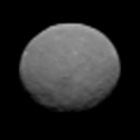 The unmanned NASA spacecraft Dawn transmits a series of pictures of Ceres, the minor planet which is the largest known object in the main asteroid belt between Mars and Jupiter, back to Earth, representing the best view yet of an object which had been seen as little more than a point of light since its discovery in 1801. From a distance of only 147,000 miles, Dawn is able to see more detail on Ceres than the best Hubble Space Telescope images of the same body. Dawn will arrive at Ceres and use its ion propulsion system to enter its orbit in March 2015.
The unmanned NASA spacecraft Dawn transmits a series of pictures of Ceres, the minor planet which is the largest known object in the main asteroid belt between Mars and Jupiter, back to Earth, representing the best view yet of an object which had been seen as little more than a point of light since its discovery in 1801. From a distance of only 147,000 miles, Dawn is able to see more detail on Ceres than the best Hubble Space Telescope images of the same body. Dawn will arrive at Ceres and use its ion propulsion system to enter its orbit in March 2015.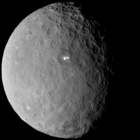 The unmanned NASA/JPL space probe Dawn arrives at its second and final destination, the dwarf planet Ceres, a body which dominates the asteroid belt between Mars and Jupiter. Beginning to bring itself into a closer mapping orbit around Ceres, Dawn has already spotted unusually bright surface features, drawing early speculation from scientists that the highly reflective points on Ceres may be indicative of ice formations or cryovolcanism. Though its main engine is powered by charged ions, Dawn is scheduled to remain at Ceres for as long as its chemical propellant supply holds, powering smaller traditional rockets needed for attitude control.
The unmanned NASA/JPL space probe Dawn arrives at its second and final destination, the dwarf planet Ceres, a body which dominates the asteroid belt between Mars and Jupiter. Beginning to bring itself into a closer mapping orbit around Ceres, Dawn has already spotted unusually bright surface features, drawing early speculation from scientists that the highly reflective points on Ceres may be indicative of ice formations or cryovolcanism. Though its main engine is powered by charged ions, Dawn is scheduled to remain at Ceres for as long as its chemical propellant supply holds, powering smaller traditional rockets needed for attitude control.